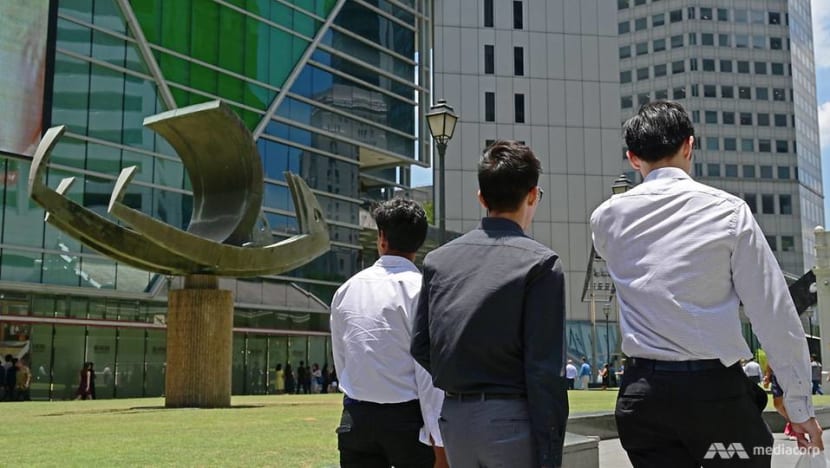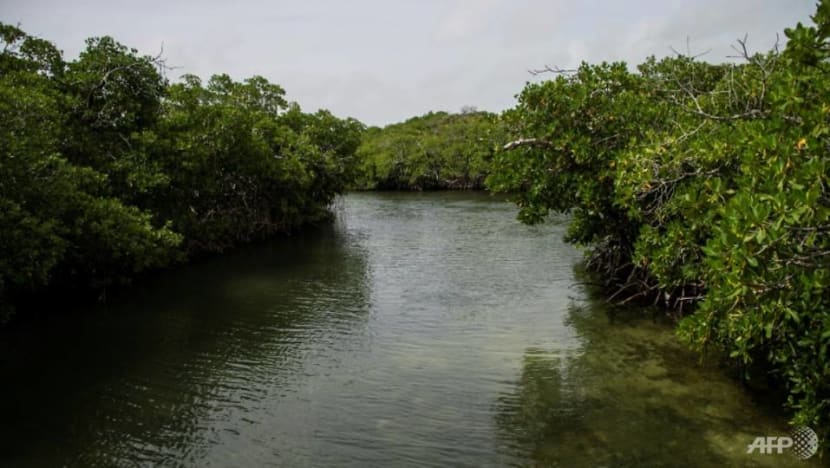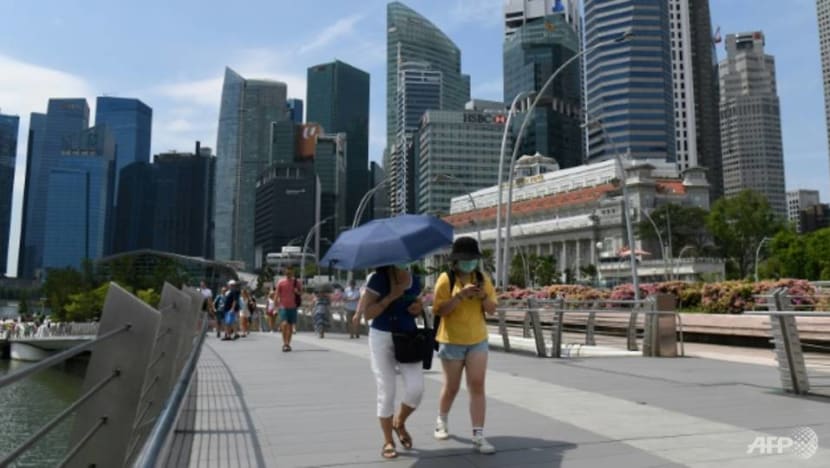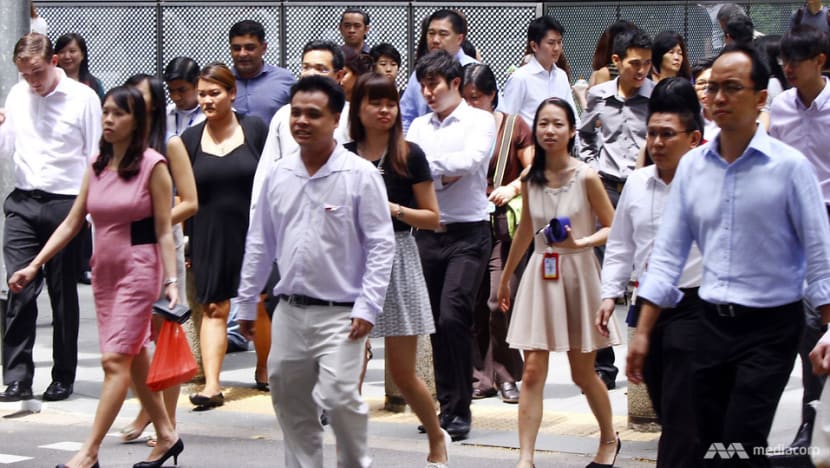commentary Commentary
Commentary: Shorts and slippers aren’t sloppy – they’re sensible attire for Singapore’s weather
We can ditch being dressed in long-sleeved shirts and pants if we rethink how we cool our buildings, says Ho Xiang Tian of LepakInSG.

Office workers at Raffles Place in Singapore. (File photo: Marcus Mark Ramos)
SINGAPORE: Singapore’s flash floods made the news once again.
According to PUB, on Apr 17, flooding occurred on pedestrian sidewalks along Dunearn Road and the park connector along Ulu Pandan Canal, due to high water levels in adjacent drains.
Photos and video clips of inundated roads and tennis courts demonstrate the disruptive effects of heavy rains, which have been par for the course. The Singapore Meteorological Service previously forecasted thundery showers in the afternoon and early evenings within the first half of April.
After the heavy rains of Apr 17, Minister for Sustainability and the Environment Grace Fu said “recent floodings have shown the effects of climate change in Singapore”, which is why mitigating climate change and adapting to its effects is necessary.
PUB has already spent S$2 billion on improving Singapore’s drainage system over the last decade, and will spend a further S$1.4 billion on flood mitigation measures over the next five years.
READ: Commentary: Why that unusually high rainfall in Singapore during the last summer monsoon may be our new normal
READ: Commentary: The world is hungry for green cooling solutions. Thankfully, Singapore is pioneering them
Mitigation and adaptation to climate change sometimes come into conflict. For example, building seawalls against rising sea levels would destroy mangroves, seagrass meadows, and coral reefs, which can sequester much more carbon than terrestrial forests.
In Singapore, data shows how our mangrove cover has declined by 90 per cent since the 50s as these made way for major developments, particularly when land was reclaimed.

In 1953, it was estimated it had 63.4 sq km of mangroves. In 2018, the country’s mangrove area was estimated to be 8.1 sq km, said Associate Professor Daniel Friess from the National University of Singapore in a past interview.
He has studied mangroves in Singapore for more than a decade.
Amid top-down directives of improving water infrastructure and finding ways to adapt, we can also think of doing something simple yet of huge personal importance in adapting to climate change: Our dress code and how we cool our buildings.
READ: How Singapore's mangroves can contribute in the battle against climate change
RETHINKING HOW WE DRESS
We need to rethink how we keep cool, and how cold our indoor temperatures are.
First, to consider a dress code suited for our tropical weather, and second, to reconsider air-conditioning as the primary mode of cooling in buildings.
Let’s talk about how we dress in sunny Singapore.
Long-sleeved shirts, pants, shoes, suits and heels are mainstays in the CBD, fitting the narrative of Singapore as a serious and slick financial centre of the world.
This fragile narrative, however, is challenged when a roaring thunderstorm or an unbearable heat wave happens, revealing disgruntled office workers who have gotten soaked in a sudden downpour during their lunch break. Or soaked from sweat just heading to and from a meeting.
READ: Commentary: Air-conditioning – the unspoken energy guzzler in Singapore

I can’t relate, as I go about almost everywhere in slippers and shorts. My renown for that is second only to my reputation as an environmental advocate.
What’s wrong with dressing down when no disrespect is meant? It’s interesting that I get several emails from event organisers explicitly stating their dress code, to prevent me from sticking out like a sore thumb.
Most people complain about Singapore’s erratic weather - it’s hot and humid, or storming and wet - but no one ever seems to complain about the dress code that amplifies discomfort in Singapore’s weather.
But wearing something as comfortable as sandals or slippers, is the most sensible thing for our increasingly volatile weather.
READ: Commentary: Reducing household water consumption starts with the toilet bowl
There would be concerns about looking presentable, especially to foreign counterparts, but I would argue that the definition of “presentable” would change if our dress codes change, and there is nothing presentable about shirts soaked in sweat or pants wet by rain.
In fact, there is precedent for this. The Singapore Police Force is one of the institutions to recognise that it makes sense to wear shorts in Singapore, with bermudas being made a part of the uniform for Police Coast Guard officers on Pulau Ubin in 2005, and Community Policing Officers now wearing shorts while on patrol around Singapore’s neighbourhoods.
If our dress code changes, buildings can finally be redesigned to reduce heat gain and cooled with only mechanical and natural ventilation.
Working from home has also made athleisure, the mainstay of Big Tech staff around the world, mainstream office wear. Do we really want to give up personal comfort and sensible dressing, which aids productivity and more?
(Listen to James Trevelyan, engineer and founder of a personal air-conditioner company talk about how to keep the planet cool without harming it.)
TOO MUCH AIR-CON?
Another problem we have is how cold our buildings are. I find myself being blasted with air-con more often than I like: In public transport, at my university, at my office, in shopping malls, even at sustainability events. We must be the only tropical country where people wear cardigans all day.
Air-con came to Singapore in the 1950s, the first air-conditioned shopping mall opened in 1973, and almost all shopping malls have been air-conditioned ever since.
Founding Prime Minister Lee Kuan Yew famously said that air-conditioning was the single most important invention of the 20th century, crediting it with making development in the tropics possible.
Perhaps this is why Singapore’s buildings are increasingly build around air-con. Most office buildings are also designed with lots of glass, allowing light and heat into the building, increasing the cooling load.
READ: Commentary: We lived fine without air conditioning for a very long time
The waste heat from air-conditioning units also contribute to the urban heat island effect, making it even hotter outside the building and contributing to climate change.
Air-conditioning accounts for up to 25 per cent of household electricity consumption, and 60 per cent of non-residential buildings’ electricity consumption. This translates to about 10 per cent of Singapore’s carbon emissions.
While there are electricity-saving initiatives like the Greenmark scheme for buildings and the Minimum Energy Performance Standards for households, they cannot achieve a drastic reduction in energy needed for cooling, which is crucial for mitigating climate change, unless made mandatory. But even that needs time.

The Government has declared climate change to be a global emergency. I believe this means Singapore needs to reconsider the existing ways of doing things, and be bold enough to change attitudes in order to mitigate and adapt to climate change.
As a slipper-wearing environmentalist, I hope that we can change our lifestyles and the way buildings are designed not only to mitigate and adapt to climate change, but also to suit Singapore’s warm and wet weather.
Ho Xiang Tian is the co-founder of informal environmental group LepakInSG.














